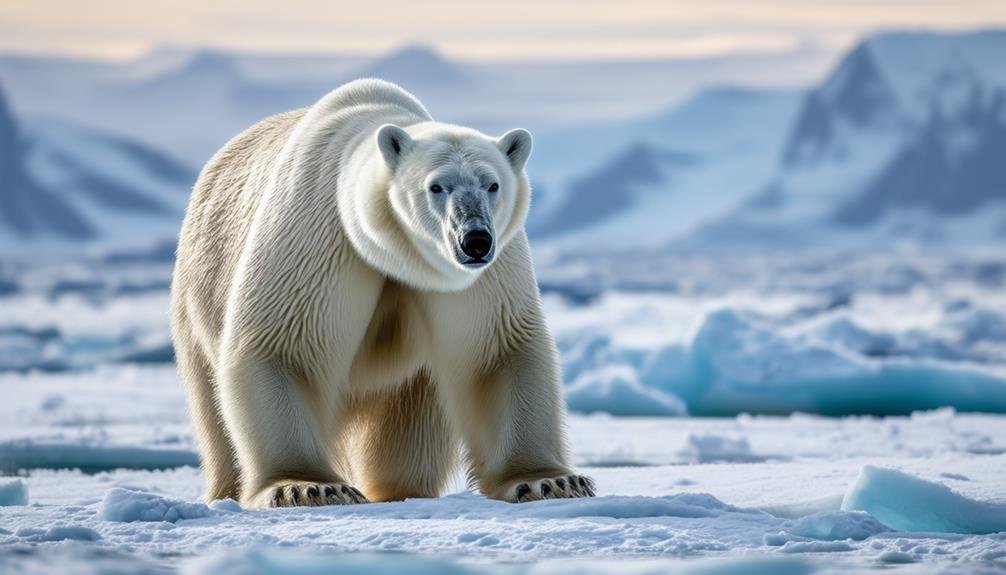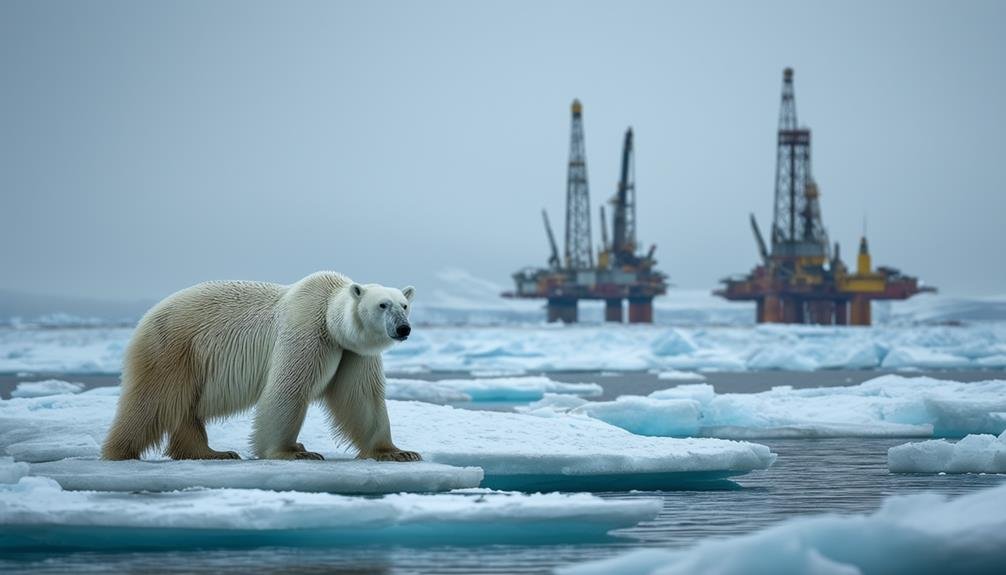Polar bears in the Arctic face numerous challenges largely driven by climate change, which disrupts their hunting and energy-storing platforms due to earlier ice melts. Habitat loss is a significant issue as longer ice-free seasons impact essential activities such as hunting and breeding. Increasing human-wildlife conflicts arise as bears venture into human areas, raising safety concerns. Pollution exposes polar bears to harmful chemicals, threatening their health and reproductive rates. Industrial activities, especially oil spills, further damage their habitat. Conservation efforts involving community collaboration and sustainable industrial practices are essential for mitigating these impacts and ensuring the species' survival. Learn more about these efforts and their significance.
Main Points
- Climate change leads to extended fasting periods for polar bears due to early melting of Arctic ice.
- Habitat loss from melting sea ice affects polar bear hunting, breeding, and denning activities.
- Increased human-wildlife conflict arises as polar bears venture into human areas seeking food.
- Pollution in the Arctic exposes polar bears to harmful chemicals, impacting their health and reproduction.
- Industrial activities like oil spills threaten polar bear habitats and pose significant health risks.
Climate Change
Climate change poses a critical threat to polar bears by disrupting the formation and melting cycles of sea ice, their primary hunting and energy-storing platform. Polar bears rely heavily on the sea ice habitat to hunt seals, their main source of food. However, with the Arctic ice melting earlier in the spring and forming later in the autumn, these majestic creatures face longer periods without access to their primary prey. This extended fasting period leads to significant energy deficits, causing polar bears to become lighter and enter poor physical condition.
The consequences of these changes are dire. Unhealthy bears exhibit reduced reproductive rates and higher cub mortality, posing severe threats to polar bear populations. If the current trends continue, many local populations may face the risk of extinction due to insufficient fat reserves necessary for survival. Moreover, the decline in sea ice impacts the entire Arctic wildlife range, affecting not just polar bears but also the seals they hunt. As the climate continues to warm, the challenges for polar bears in maintaining their energy balance and ensuring their survival become increasingly pronounced, highlighting the urgent need for global action to mitigate climate change.
Habitat Loss
Due to the melting Arctic sea ice, polar bears are experiencing significant habitat loss, which severely impacts their ability to hunt, breed, and den. This habitat loss is primarily driven by climate change, which is causing longer ice-free seasons. As the sea ice diminishes, polar bears struggle to find food, particularly seals, their primary prey species. The reduction in suitable hunting grounds leads to nutritional stress and a decline in polar bear populations.
Additionally, the melting of Arctic sea ice affects denning areas, which are vital for polar bear reproduction. Pregnant females require stable ice and snow to construct dens, where they give birth and nurse their cubs. The degradation of these denning sites due to warming temperatures and ice melt compromises the survival of newborn cubs.
Moreover, industrial activities such as oil and gas exploration exacerbate habitat loss by causing further fragmentation and environmental degradation. These activities disturb critical polar bear habitats, making it increasingly challenging for them to find safe and suitable areas for hunting and denning.
Conservation efforts are necessary to mitigate the impact of habitat loss on polar bears. Protecting their denning areas and regulating industrial activities in the Arctic can help preserve this iconic species amidst the challenges posed by a changing climate.
Human-Wildlife Conflict

As polar bears lose their natural habitats to melting sea ice, they increasingly venture into human communities, leading to a rise in human-wildlife conflicts. The powerful sense of smell of polar bears draws them to human settlements, where food sources are more accessible. This situation exacerbates encounters and conflicts, posing significant safety risks for both humans and bears.
Community efforts have become pivotal in mitigating these conflicts and ensuring safe coexistence. Initiatives supported by organizations like WWF include providing steel food storage containers and installing electric fences to deter polar bears. These measures help safeguard property and reduce the likelihood of dangerous encounters.
Coastal villages, experiencing the brunt of these changing habitat conditions, report more frequent sightings and interactions with polar bears. Collaboration between conservation groups and local communities is vital to addressing these challenges, promoting strategies that enhance safety and minimize conflicts.
| Key Issue | Impact | Solution |
|---|---|---|
| Melting sea ice | Polar bears venturing into human areas | Habitat preservation |
| Sense of smell | Attracts bears to human food sources | Secure food storage |
| Increased encounters | Rising safety risks for humans and bears | Community awareness programs |
| Habitat conditions | Displacement and altered bear behavior | Collaborative conflict mitigation |
Through these efforts, a balanced approach to human-wildlife conflict can be achieved, fostering a safer environment for both polar bears and human communities.
Pollution
Pollution poses a severe threat to polar bears, exposing them to high levels of harmful chemicals through their diet, which adversely affects their health and reproduction. The Arctic environment, though seemingly pristine, is increasingly contaminated with toxic chemicals stemming from industrial development. These pollutants accumulate in the food chain, ultimately impacting polar bears.
- Health declines: Polar bears experience declining health due to the accumulation of pollutants in their tissues.
- Reproduction rates: High concentrations of toxic chemicals in a mother's milk can poison cubs, leading to lower survival rates.
- Vital biological functions: Some pollutants can impair essential biological functions, further compromising their well-being.
- Long-term effects: The accumulation of contaminants poses long-term health risks, potentially affecting the population's future viability.
Industrial development introduces a variety of toxic chemicals into the Arctic, which are carried by air and water currents from distant regions. Indigenous peoples, who share this environment, are also affected by this pollution, highlighting the broader impact on the ecosystem. Effective wildlife conservation efforts are essential to mitigate these adverse effects, ensuring that polar bear populations can thrive despite the ongoing threat of pollution. Addressing these challenges requires a collaborative approach that includes monitoring pollutant levels and enforcing stricter regulations on harmful substances.
Industrial Impacts

Industrial development in the Arctic, particularly from oil and gas operations, poses significant threats to polar bears and their fragile habitat. The expansion of such activities leads to severe habitat destruction, jeopardizing the very landscape that polar bears depend on for survival. One of the major risks includes oil spills, which can result in poisoning and reduced insulation of polar bear fur, significantly affecting their ability to withstand the harsh Arctic climate.
| Impact Type | Consequences |
|---|---|
| Oil Spills | Poisoning, insulation reduction |
| Habitat Destruction | Loss of essential denning sites |
| Industrial Disturbance | Disruption of natural behaviors |
The proximity of industrial activities to denning sites is particularly concerning. Disturbances near these areas can lead to the abandonment of dens, putting cubs at risk. This underscores the need for sustainable standards and rigorous management to mitigate these dangers. Organizations like the WWF are advocating for stringent oil spill prevention measures and sustainable industrial practices to safeguard Arctic wildlife.
Continuous vigilance and careful management are necessary to shield polar bears from the adverse effects of industrial development. As we move forward, it is vital to balance economic pursuits with the preservation of the Arctic ecosystem to guarantee the survival of these majestic creatures.
Conservation Efforts
Conservation efforts for polar bears are greatly strengthened by community collaboration initiatives and the promotion of sustainable industrial practices. By integrating Traditional Ecological Knowledge (TEK) with scientific research, organizations like WWF foster a holistic approach to monitoring and safeguarding polar bear populations. Additionally, advocating for responsible industrial development guarantees that economic activities in the Arctic do not jeopardize the delicate ecosystems essential to the survival of these iconic animals.
Community Collaboration Initiatives
Through collaborative efforts between local residents and organizations like WWF, community initiatives are being implemented to protect polar bears and foster safe coexistence. These partnerships are pivotal in addressing the challenges posed by increasing interactions between humans and polar bears. By focusing on preventative measures, these initiatives aim to reduce conflicts and enhance conservation efforts.
Key strategies being employed include:
- Steel food storage containers: These are provided to local residents to securely store food and waste, thereby minimizing attractions for polar bears.
- Electric fences: Installed around communities and campsites, electric fences act as deterrents to keep polar bears at a safe distance.
- Polar bear patrols: Local residents participate in patrols to monitor and manage polar bear movements, ensuring that both humans and bears remain safe.
- Educational programs: These initiatives educate communities about polar bear behavior and effective ways to minimize conflicts.
Sustainable Industrial Practices
Adopting sustainable industrial practices is vital to mitigate the adverse effects of economic activities on polar bears and their fragile Arctic ecosystem. Sustainable practices are necessary for protecting these magnificent creatures and their habitat from harmful impacts. Conservation efforts emphasize promoting responsible resource extraction and minimizing disturbances to the polar bear population.
Monitoring industrial activities guarantees that development in the Arctic does not compromise the wellbeing of polar bears or their environment. Balancing economic interests with wildlife conservation is crucial to safeguarding polar bear populations. Advocacy for high development standards and stringent oil spill prevention measures is vital for preserving the integrity of the Arctic habitat.
By integrating sustainable practices, industries can contribute to both economic growth and the protection of polar bears. This approach includes implementing rigorous monitoring systems and adhering to best practices for responsible resource extraction. Minimizing disturbances to polar bear populations and their habitat is a crucial component of sustainable development in the Arctic region.
Ultimately, adopting sustainable industrial practices not only benefits polar bears but also fosters long-term ecological stability. High development standards and effective oil spill prevention are pivotal in guaranteeing that industrial activities coexist harmoniously with the Arctic's unique wildlife and environment.
What Are the Main Challenges Polar Bears Face in Their Arctic Habitats That Require Protection?
Polar bears face numerous challenges in the Arctic, including melting sea ice, reduced access to prey, and human encroachment. Climate change continues to alter their environment, making *polar bear habitat protection* increasingly urgent to ensure their survival and preserve the delicate balance of their unique ecosystem.
Conclusion
To sum up, polar bears face significant challenges from climate change, habitat loss, human-wildlife conflict, pollution, and industrial impacts. These factors collectively threaten their survival, necessitating urgent and thorough conservation efforts. Addressing these issues requires coordinated actions from governments, conservation organizations, and local communities to implement effective strategies. Ensuring the long-term survival of polar bears and other Arctic wildlife hinges on mitigating these threats and fostering a sustainable coexistence between human activities and the natural environment.


